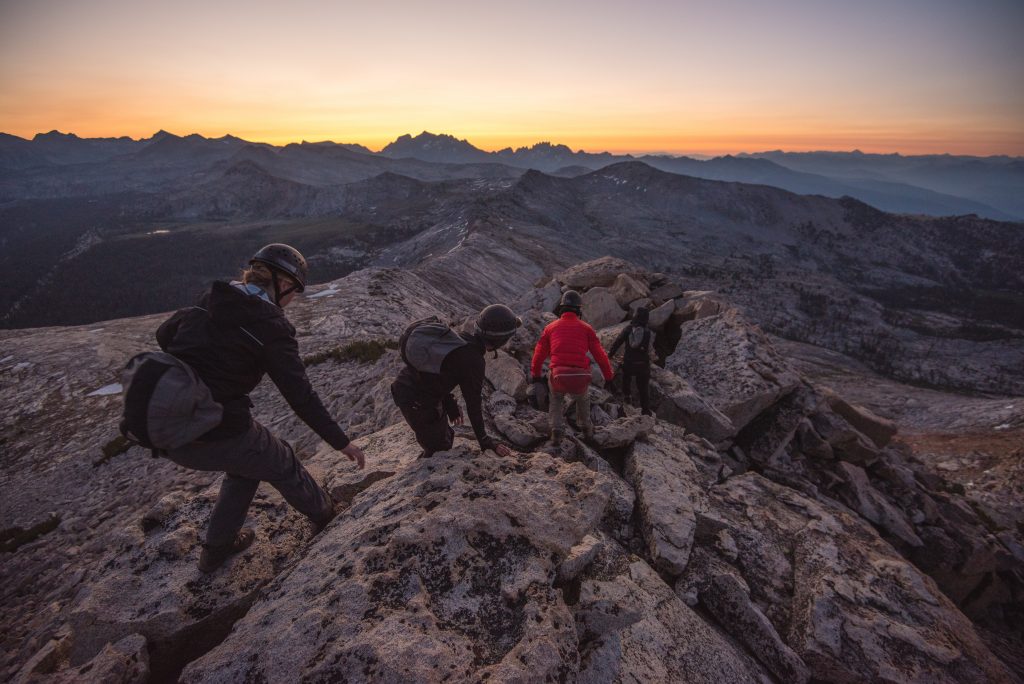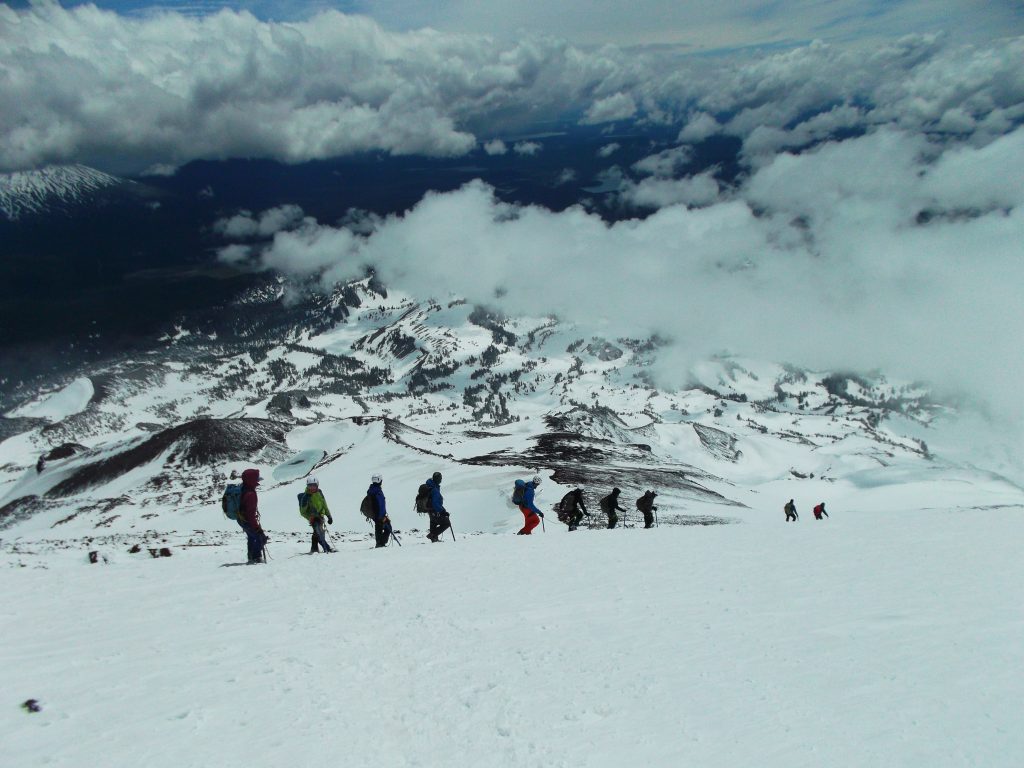Originally published May 24, 2017 and updated on February 7, 2022.
What comes to mind when you hear the word “mountaineering?” Perhaps you picture climbers roped together in single file making their way to the summit of a big mountain? Do you think of an ice axe, or maybe a winter view of snow-covered peaks?

The word “mountaineering” indicates travel on snow, and possibly glaciers or ice to reach a summit.
Mountain climbing vocabulary can be confusing. Climbing a mountain can mean hiking a trail up to the top of a mountain, or refer to a day hike or longer backpacking trip. The term “alpine climbing” often means climbing on rocks as you make your way to the top of a peak. “Rock climbing” can refer to climbing indoors at a commercial climbing gym or outside on a rock face with ropes for safety. The word “mountaineering” indicates travel on snow, and possibly glaciers or ice to reach a summit.
Because It Is There
George Leigh Mallory, a famous British mountaineer, once famously responded to the question of why he would want to climb Mt. Everest with the answer, “Because it’s there.”
Through the ages, humans have climbed mountains for many reasons. Sometimes they climbed for safety, as a view from up high might alert them of an approaching threat. Many people have climbed for adventure; what is above knows what is below. And yes, some people climb because it’s there. Others find deep spiritual meaning in mountains, or have had sacred experiences there.

Through the ages, humans have climbed mountains for many reasons.
Know Your Fundamentals
Mountaineering has hazards, as does any adventurous activity. Outward Bound Instructors are equipped to safely manage the risks involved. Instructors are certified as Wilderness First Responders, Wilderness Advanced First Aiders, or the equivalent, and meet all Outward Bound local, state and federal requirements for their positions. They teach students the fundamentals of safe travel in snow and mountains, including how to read terrain and choose a smart route and cover the topics of snow science and avalanche safety.
Let’s compare mountaineering to driving in the winter. For winter travel, you might take extra precautions to be sure your vehicle is in good shape for a trip, has good tires, the appropriate amount of anti-freeze and perhaps chains. You might keep safety items handy in case of being stranded: a warm blanket, emergency food, flares and a phone. You might practice steering on snow and ice in a vacant parking lot to see how your car responds to icy conditions. There are many precautions a driver can take to minimize or eliminate the risks of winter driving. By preparing for what CAN happen, you decrease the risk of something bad happening. In the process of preparing, you might imagine scenarios where you wouldn’t want to be out on the road, and could choose to avoid going out in lousy weather to avoid the risk.
In mountaineering, personal preparedness and skill development are also important. Mountain weather can be finicky, and there’s no guarantee you’ll get to the top, so enjoy the experience, the challenge of being out in winter conditions and the teamwork involved. If all the stars align, you may have the unique opportunity to stand on a summit, savoring the effort and that top-of-the-world feeling. You won’t linger long, though. You still have the long journey down.
To prepare for the climb, Instructors teach many skills, including the fundamentals of self-care in a cold environment: eating enough calories, drinking fluids, preventing hypothermia and dressing in layers. You’ll learn winter camping skills, including melting snow for water if necessary, setting up a shelter in snow country and choosing a good campsite. You may even learn to use snowshoes or cross-country skis.

To prepare for the climb, Outward Bound Instructors teach many skills, including the fundamentals of self-care in a cold environment
On one of my early mountaineering expeditions, we carried heavy backpacks, with ropes and ice axes, crampons, food to last us for ten days and all of our camping gear. The snow was soft and our feet dropped deep into the snow, making travel exhausting. Sometimes the snow was so soft we went in the snow up to our hips! Going with experienced mountaineers helps you learn without as many hard lessons from the school of hard knocks.
Skills You’ll Learn
As you approach your first mountain, you’ll participate in “snow school” where each student practices the essential skill of self arrest. While on a moderate mountainside, the ice axe is held in a way that the pick digs into the snow, and the climber holds the axe as an anchor to stop a slide. Self arrest practice gives the climber confidence that they can regain a steady position should they slip on a steep slope. You’ll also learn to travel as a rope team, and other safety techniques.
Additional skills you could learn include putting crampons on your boots. These specially designed devices have teeth which grab onto hard snow or ice, allowing you to walk without slipping.
During a day of mountaineering, you’ll likely use an ice axe and crampons and also learn rope techniques to ensure a successful climb.
An Outward Bound mountaineering course allows time to master the art of living outside in winter as the group approaches their mountain goal. The summit may be the ultimate goal, but each individual must learn good self-care, teamwork and important communication skills along the way.
Members learn to be in tune with the weather and each other. Is anyone getting too cold? Do we need to stop and eat more calories? How much daylight is left, and do we need to consider looking for a campsite? Do we need to melt more snow for water before leaving camp? No one will climb the mountain alone. It’s a team effort.
Hard Work Pays Off
Summit day is exciting. Preparations have been made the night before so that each person knows what to pack, how much water to carry and what gear is needed to start the climb.
If the weather doesn’t cooperate, summit day may be elusive. This is the nature of mountains. With good luck, the weather will be kind. The group will start their day with what is called an alpine start. In many situations climbers want to get a super early start to have plenty of daylight to make it to the top and back to camp. It can also be a huge advantage to travel in the dawn hours when snow is hard. Snow exposed to sunlight for hours can become soft, and boots can plunge deep down into the snow, making the simple act of walking uphill quite challenging.
Mountaineering is hard work, and often done in cold conditions. To do it requires great physical effort and some practiced skill. It also requires some luck. If the stars align and your team is feeling strong, you’ve mastered the skills you need, and if the weather cooperates, you may be rewarded with an unforgettable 360 degree view of summits around you and memories that last a lifetime.

The view from the summit is an experience you’ll never forget.
About the Author
CJ Wilson is a former Outward Bound Instructor whose love of mountaineering has taken her from the western US to the Andes of Colombia, Ecuador, Peru and Bolivia.
OTHER POSTS YOU MAY LIKE
Read More
Read More
Read More




